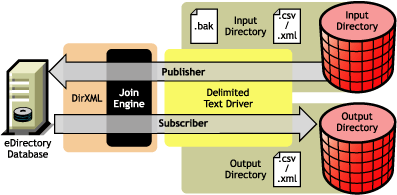Default Driver Configuration
This section provides information on the following:
For information on Identity Manager fundamentals, see the Nsure Identity Manager Administration Guide.
Data Flow
Publisher and Subscriber Channels
The Driver for Delimited Text supports Publisher and Subscriber channels:
- The Publisher reads information from input text files on your local file system and submits that information to eDirectory via the DirXML engine.
By default, the Publisher does the following:
- 1. Checks the input directory every 10 seconds.
- 2. Processes any files that have a .csv extension.
- 3. Changes .csv extensions of processed files to .bak.
- 4. Cycles through this process until you stop the driver.
- The Subscriber watches for additions and modifications to eDirectory objects and creates output files on your local file system that reflect those changes.
By default, the Subscriber keeps an output file open until either 200 transactions have been logged or 30 seconds have elapsed. When either of these thresholds is reached, the output file is saved with a number.csv filename and a new output file is opened.

The sample configuration that ships with this driver includes both Subscriber and Publisher channels. However, in many configurations, only one-way data flow is required. In those configurations, only a Publisher or Subscriber channel is used. The other channel is disabled.
Policies
Policies are used to control data synchronization between the driver and eDirectory. The Driver for Delimited Text comes with the set of preconfigured policies detailed in the following table. You can customize these policies by using Novell iManager, as explained in Customizing the DirXML Driver for Delimited Text .
Schema Map |
Configured on the driver object. Maps eDirectory User properties to application attributes as follows: - Surname > LastName
- Given Name > FirstName
- Title > Title
- Internet EMail Address > Email
- Telephone Number > WorkPhone
- Facsimile Telephone Number > Fax
- mobile > WirelessPhone
- Description > Description
The application attributes correspond to the sequence of values in the file or, if present, to the attributes associated with unnamed XDS <field> elements. |
Input Transform |
Configured on the driver object. If the input document is an XML document, no transformations are made. If the document is a delimited text file, each record is transformed into an XDS add element for User objects with attributes defined by the schema map. The user CN is formed by concatenating the values of first name and last name. Associations are defined by value the user's e-mail attribute. |
Output Transform |
Configured on the driver object. Specifies that a comma is used as the delimiter character for output files and that the file format is Comma Separated Values (CSV). |
Create |
Configured on the Publisher channel. Specifies that in order for a User to be created in eDirectory, the Given Name and Internet EMail Address attributes must be defined. |
Matching |
Configured on the Publisher channel. Specifies that a user in eDirectory is the same user specified in the input file when the value of Internet Email Address is the same in both places. In the case of a match, only changed attributes are updated in eDirectory. |
Placement |
Configured on the Publisher channel. Specifies that a new user is placed in the Users\Active container and named with the CN created by the Input Transform rule. You need to create a Users\Active container at the root of your tree before you start the driver. |
Event Transform |
Configured on the Subscriber channel. If eDirectory reports a Modify or Sync event, those events are changed to an instance element that can be used to create a complete output record. |
Supported File Types
The sample configuration currently supports two types of files:
Comma-Separated Values Files
Comma-separated values (CSV) files are text files that contain data divided into fields and records. Fields are delimited by commas, and records are delimited by a hard return.
If you need a comma or hard return within the value of a particular field, the entire field value should be enclosed in quotes.
Because the meaning of each field in a CSV file is derived from its position, each record in a CSV file should have the same number of fields. Field values can be left blank, but each record should have the same number of delimiter characters.
XML Files in XDS Format
XDS format is the defined Novell subset of possible XML formats. This is the initial format for data coming from eDirectory. By modifying default rules and changing the style sheets, the Delimited Text driver could be configured to work with any XML format.
For detailed information on XDS format, refer to NDS DTD Commands and Events.
For information on configuring the driver to use XML files in the XDS format, refer to Configuring for XDS XML Files.
